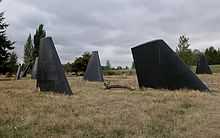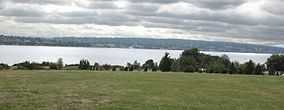Magnuson Park
| Warren G. Magnuson Park | |
|---|---|
|
Magnuson Park and Lake Washington | |
 Location of Magnuson Park in Seattle | |
| Type | Urban park |
| Location | Seattle, Washington |
| Coordinates | 47°40′51″N 122°14′53″W / 47.6808°N 122.2481°WCoordinates: 47°40′51″N 122°14′53″W / 47.6808°N 122.2481°W |
| Area | 350 acres (1.4 km2) |
| Created | 1900 (military use 1922-1975) |
| Operated by | City of Seattle |
| Status | Open year round |
| Website | Official website |
Magnuson Park is a 350 acre (1.4 km²) park on Sand Point at Pontiac Bay, Lake Washington, in the Sand Point neighborhood of Seattle, Washington. The park is the second largest in Seattle, after 534 acre (2.2 km²) Discovery Park in Magnolia. It is located on the spot of the former Naval Station Puget Sound. Sand Point is the peninsula with Pontiac and Wolf bays that juts into Lake Washington in northeast Seattle.[1]
Geography
Sand Point is a peninsula that juts into Lake Washington between Wolf Bay and Pontiac Bay. It is occupied by Magnuson Park, parts of View Ridge, Windermere and gives its name to the Sand Point neighborhood to the west.[1] Formerly the easternmost point was Naval Air Station-Sand Point; the former military base is now mostly public park with a portion occupied by the NOAA western regional center[2] and by city housing.[3]
History
Early history
The area has been inhabited since the end of the last glacial period (c. 8,000 BCE—10,000 years ago). Prairie or tall grassland areas (anthropogenic grasslands) were maintained along what is now Sand Point Way NE (map ), among numerous locations in what is now Seattle.[4] The Xacuabš (Xachua'bsh or hah-choo-AHBSH, "the People of the Large Lake", now of the Duwamish tribe) had the village of TLEHLS ("minnows" or "shiners") on the shores of what is now called Wolf Bay in Windermere, on Lake Washington south of SqWsEb, now called Sand Point-Magnuson Park. BEbqwa'bEks ("small prairie"—anthropogenic grassland) was near what is now Windermere. One or three sizable longhouses have been documented. Villages were diffuse.[5] These people may have been associated with the hloo-weelh-AHBSH of Union Bay. Just on the other side of Sand Point, the village of too-HOO-beed was of the too-oh-beh-DAHBSH extended family, near what is now called Thornton Creek at what is now Matthews Beach, so Sand Point was their shared "side yard".[6]
Naval use
The first park at Sand Point was established in 1900 as Carkeek Park, a gift from developers Mr. and Mrs. Morgan J. Carkeek. After World War I, a movement was begun to build Naval Air Station (NAS) Seattle at Sand Point, and King County began acquiring surrounding parcels. In 1922 the U.S. Navy began construction on the site, which it was leasing from the county, and in 1926 the Navy was deeded the 413-acre (1.67 km2) field outright. The name Carkeek Park was subsequently given to a new park on the west side of the city, north of Ballard on Puget Sound. This deed amounted to a public gift of $500,000 from the county to the Navy, in 1926 dollars; this would be $5,283,000 in 2005 dollars, not including significant real estate appreciation.[7] The facility then became known Naval Air Station Sand Point.
Naval Air Station Seattle was deactivated in 1970 and the airfield was shut down; the reduced base was renamed "Naval Support Activity Seattle." Negotiations began as to who would receive the surplus property.
As a city park
In 1975 a large portion of the Navy's land was given to the City of Seattle and to the National Oceanic and Atmospheric Administration (NOAA). The city's land was largely developed as a park and named Sand Point Park. In 1977, it was renamed Magnuson Park in honor of longtime U.S. Senator Warren Magnuson, a former naval officer from Seattle. Both names for the park are commonly used. The airfield runways were demolished in the late 1970s and new construction on the north end for NOAA was completed in 1982 (photo - 1981).
Amenities

Magnuson Park today features several sports fields, a picnic area, a swimming beach, public sailboating,[8] many paths for walking and bicycling, a dog park or off-leash dog area and "Kite Hill", a large grassy man-made hill constructed in the 1980s from earth and pavement pieces of the old airfield tarmac. Vehicle access includes boat launch ramps and large parking lots for cars, trucks, and boat trailers.
The park also has a history of unofficial clothing-optional use since the mid-1970s.
Sports fields
The Sports Meadow, a 12 acre (5 ha) natural grass athletic field area, was developed in the early 1980s near the center of the former main runway. Rebuilt in 2004-05 and raised nearly eight feet to improve drainage, it is now divided into four unlit soccer fields.[9] As of 2005, the City of Seattle had a development plan that featured a large sports field complex of approximately ten fields, with seven well lit. The plan had encountered opposition from neighborhood groups, environmental and park advocates.
The plan was amended to five new athletic fields with an engineered wetlands area, with additional pavement areas removed and construction of new walking trails. Opened in April 2009 southeast of the Meadow area, the first three fields (all lit with synthetic turf) are primarily for rugby (field # 5) and soccer (# 6, 7). Later in the year the baseball field (# 8, unlit) and softball field (# 9) to the south were completed, but were not opened until late 2010 to allow the natural grass outfields to mature. Runoff from the athletic fields feeds the wetlands area and restrictions on lighting were enacted; no late nights or Sundays.[10][11]
Wetland restoration
Sand Point provides habitat for the second richest bird habitat of any park in Seattle, with 170 species reported including pine siskins, Anna's hummingbirds, and black-capped chickadees.[12] Wildlife diversity has been improved in part by a wetlands restoration project that radically transformed the park's landscape and hydrology.
Sand Point was substantially regraded during construction of the naval air station. Existing marshlands were eliminated with fill or paved over and the point's natural slope was flattened. Runoff was channelled into storm drains, and around 20% of the park's surface was rendered impervious with concrete and asphalt.[13]
As the storm drains aged, they became less effective at channelling water to the lake, leading to an increase in sheet flow runoff and oversaturation of the park's sports fields. The irregular runoff patterns also resulted in substantial volume of untreated water draining into Lake Washington.
The Wetlands Restoration project created a set of mounds, plateaus, valleys and ponds to channel water more effectively and improve drainage of oversaturated areas. This constructed wetland and provide natural filtration of urban drainage water and reduces pollution in Lake Washington.[14]
Part of the wetlands project included the removal of the parking lot at the south end of the Sports Meadow and the demolition of Building 193 at the south end of the park. Built in 1943 as a hangar for transport aircraft, it was later the base's commissary and exchange; it was removed in December 2006.[15] 30 acres (12 ha) of wetlands, including walking paths and observation points, were completed in 2009.[10][11] The next phase of wetland restoration was completed in late 2011.
Playground
Magnuson Park is home to Seattle's biggest playground, the Junior League of Seattle Children's Playground which was designed, developed and funded through the efforts of the Junior League of Seattle, a women's leadership and volunteer organization. Opened in 1999 and spearheaded by prominent Seattle resident, Mary Herche, the Playground celebrated its 10th anniversary on Saturday, May 16, 2009, where children played in the 20,000 square feet (1,900 m2) of colorful climbing walls, sand box, swings, slides and much more.
The Junior League of Seattle donated and dedicated this "Air, Land and Sea" playground to the children of Seattle to commemorate the organization's 75 years of community service. The playground was designed partly by children and built entirely by volunteers at the site of the former Naval Air Station Control Tower.
See also
- The Sound Garden
References
- ↑ 1.0 1.1 "Area 4". Seattle City Clerk's Neighborhood Map Atlas. Office of the Seattle City Clerk. n.d., map .jpg dated 2002-06-14. Retrieved 2006-04-21.
- ↑ "NOAA Western Regional Center". NOAA: National Oceanic and Atmospheric Administration. Retrieved September 16, 2012.
- ↑ "Low-income housing readied at Sand Point". Real Estate Notebook (Puget Sound Business Journal). 2000-05-12. Retrieved 2006-08-21.
- ↑ Talbert, Paul (2006-05-01). "SkEba'kst: The Lake People and Seward Park". The History of Seward Park. SewardPark.org. Archived from the original on 2005-12-14. Retrieved 2006-06-06.
- ↑ Village size appears indeterminate. Since native populations in the region crashed 1774-1874 [Burrows], the discrepancy may simply be when in as little as a few decades. Forerunners of cohousing, each longhouse was home for tens of people.
(1) Dailey (2006-06-14) reports one longhouse, citing
(1.1) Buerge, David (1–7 August 1984). "Indian Lake Washington". Seattle Weekly. and
(1.2) Waterman, T. T. (n.d.). "Puget Sound Geography". Washington, DC: National Anthropological Archives, mss.
(2) Dailey, Tom (2006-06-14). "Duwamish-Seattle". "Coast Salish Villages of Puget Sound". Retrieved 2006-04-21.
See Duwamish tribe#Bibliography for complete citation.
(3) "History - Pre-Euro American Settlement". Magnuson Park. Seattle Parks and Recreation. 2005-11-25. Retrieved 2006-04-21.
Page reports place names and three longhouses, but cites no sources. - ↑ Dailey (2006-06-14)
- ↑ Sahr, Robert (25 May 2006, minor corrections to revision 12 April 2006). "Inflation Conversion Factors for Dollars 1665 to Estimated 2016". Oregon State University. Retrieved 2006-07-21. Check date values in:
|date=(help) - ↑ Johnston, Greg (2002-08-22). "Sand Point program makes boating accessible to youngsters of all backgrounds". Outside (Seattle Post-Intelligencer). Retrieved 2006-04-21.
- ↑ "Magnuson Park - sports fields". Seattle.gov. Retrieved 2010-10-24.
- ↑ 10.0 10.1 Seven, Richard (2009-03-23). "Ballfields and wetlands: Magnuson Park's makeover nears completion". The Seattle Times. Retrieved 2010-10-24.
- ↑ 11.0 11.1 Easton, Valerie (2010-02-20). "Seattle's Magnuson Park makeover attracts all kinds of creatures". The Seattle Times. Retrieved 2010-10-24.
- ↑ Arnold, Alice; Marshall, Kristin; Ward, Eric; Curl, Herb (May 2006). "The Neighborhood Bird Project at Magnuson Park". Seattle Audubon Society. Retrieved September 16, 2012.
- ↑ "Stormwater Technical Information - Warren G. Magnuson Park, Phase 2" (PDF). Magnusson Klemencic Associates. March 16, 2007. Retrieved September 16, 2012.
- ↑ Jurries, Dennis (January 2003). "BIOFILTERS (Bioswales, Vegetative Buffers, & Constructed Wetlands) For Storm Water Discharge Pollution Removal" (PDF). DEQ Northwest Region Document. State of Oregon Department of Environmental Quality. Retrieved September 16, 2012.
- ↑ Bhatt, Sanjay (2006-12-09). "Demolition begins at Magnuson Park site". The Seattle Times. Retrieved 2010-10-24.
Further reading
- Dolan, Maria and True, Kathryn (2003). "Wide Open Spaces: Sand Point Magunson Park" in Nature in the city: Seattle, pp. 224–231. Seattle: Mountaineers Books. ISBN 0-89886-879-3 (paperback)
- Walter, Sunny and local Audubon chapters (updated 10 February 2006). "Sunny Walter's Washington Nature Weekends: Wildlife Viewing Locations - Greater Seattle Area". Retrieved 21 April 2006. Walter excerpted from Dolan, Maria & True, Kathryn (2003). Nature in the city: Seattle. Seattle: Mountaineers Books. ISBN 0-89886-879-3 (paperback).
[with additions by Sunny Walter and local Audubon chapters.]
External links
| Wikimedia Commons has media related to Magnuson Park. |
- Magnuson Park, Seattle Parks and Recreation
- Magnuson Park History, Seattle Parks and Recreation
- Magnuson Environmental Stewardship Alliance
- The Fin Project public art in Magnuson Park
